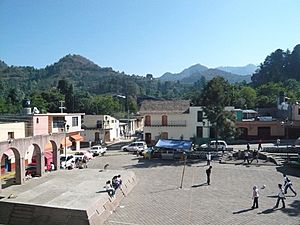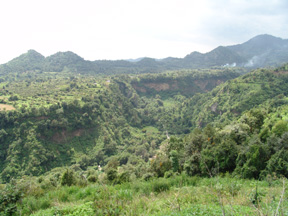Hueyapan, Morelos facts for kids
San Andrés Hueyapan is a small town in the state of Morelos, Mexico. It is located in the rural northeastern part of the state. The town sits high up, about 2000 to 2500 meters (6,500 to 8,200 feet) above sea level. It is on the southern slopes of the active volcano Popocatépetl.
To the west of Hueyapan is the Amatzinac river. North of the town is the Popocatépetl-Iztaccíhuatl natural reserve. To the south is the town of Tlacotepec. East of Hueyapan is the municipality of Tochimilco, which is in the state of Puebla.
Hueyapan became its own independent municipality on January 1, 2019. Before this, it was part of the municipality of Tetela del Volcán. Other new municipalities created at the same time were Xoxocotla and Coatetelco. On July 15, 2020, Hueyapan received its official "geo-statistical code" from INEGI. This made it able to get money from the federal government.
Contents
Who Lives in Hueyapan?
Most people in Hueyapan are Nahua. This means they are part of an indigenous group. About 82.7% of the 6,478 residents are indigenous. Also, 43.13% of the people speak an indigenous language. Only a very small number, 0.08%, do not speak Spanish.
The Nahuatl Language
Most adults in Hueyapan speak the Nahuatl language. The town's name, Hueyapan, comes from Nahuatl. It means on the great water. This name refers to the many water sources in the area.
Traditional Crafts and Farming
The people of Hueyapan mostly do subsistence agriculture. This means they grow food mainly for themselves and their families. They produce crops like corn, beans, squash, peaches, avocados, and plums.
Hueyapan is also famous for its woolen products. These include ponchos (called gabán locally), shawls (rebozo), and skirts (chincuete). These items are made from thick woolen cloth. The wool thread is spun using traditional tools called malacates. Natural dyes are used to color the thread. Some dyes come from plants like Añil, Walnut husks, and St John's wort. The fabric is then woven on backstrap looms.
Studying Hueyapan's Culture
The culture and identity of the Nahua people in Hueyapan have been studied. An American anthropologist named Judith Friedlander wrote a book about it. It is called Being Indian in Hueyapan.
The Nahuatl dialect spoken in Hueyapan has also been studied. Researchers like Karen Dakin and Diana Ryesky looked at the Nahuatl in Morelos. They found that Hueyapan's dialect is a typical central dialect. It also has some unique features found in Morelos. In 1949, a teacher from Hueyapan, Miguel Barrios Espinosa, published Nahuatl folktales. These stories were from Hueyapan. Today, linguists are working with speakers from Hueyapan to study Morelos Nahuatl.
A Look at Hueyapan's History
According to historical records, people from Xochimilco founded Hueyapan around 902 CE. Later, the Aztecs conquered the town under their ruler Moctezuma II. In 1521, during the Spanish conquest of the Aztec Empire, Hueyapan fell to the Spanish. This happened with the help of Gonzalo de Sandoval and a female Conquistador named María Estrada.
The Old Monastery
Between 1563 and 1573, the Dominican order built a convent in Hueyapan. It was dedicated to Santo Domingo. This building is now an ex-convent and serves as the town's Catholic church. Fray Diego Durán, a famous chronicler, stayed here for some time. It is believed he gathered much information for his writings while in Hueyapan.
In colonial times, Hueyapan was first given to the Estrada family as an encomienda. This was a system where Spanish settlers were given control over groups of indigenous people. Later, Hueyapan came directly under the Spanish king. For a long time, it was hard to get to Hueyapan from other places. However, in the last twenty years, new roads and transport have made travel much easier.
Becoming a Municipality
When Morelos became a state in 1869, Hueyapan was part of the municipality of Ocuituco. Then, in 1937, it became part of Tetela del Volcan. As mentioned earlier, Hueyapan became its own independent municipality on January 1, 2019.
In the 2000 general election, Mario Soberanes was elected president of Tetela del Volcán. He was from Hueyapan. This was the first time someone from Hueyapan held this position. It was also the first time a local president was from a party other than the PRI. In 2012, Javier Montes became the second municipal president from Hueyapan.
The 2017 Earthquake
Hueyapan was badly damaged by an earthquake on September 19, 2017. Luckily, no one died. However, between 80% and 90% of the homes were damaged. About 30% of these homes could not be repaired. Also, rocks fell and bridges were damaged on the roads leading to the town.
The Santo Domingo de Guzman Monastery
The monastery of Santo Domingo de Guzman is a special place. It is a UNESCO World Heritage Site. This means it is recognized as very important globally. It is one of the monasteries closest to the Popocatépetl volcano.
The Dominicans founded it, but they built its cloister with adobe and wood. It had a tile roof instead of stone. Because of this, it broke down quickly due to weather and was left empty. Today, most of the monastery remains closed. Only the front courtyard area is open to visitors. This area closes by 1:00 pm each day. The simple front of the main church still stands. It has a notable Baroque-style niche.
Important People from Hueyapan
- Diego Durán: A chronicler and vicar of Hueyapan in the late 1500s.
- Modesta Lavana: An indigenous healer and artisan.
See also
 In Spanish: San Andrés Hueyapan para niños
In Spanish: San Andrés Hueyapan para niños



